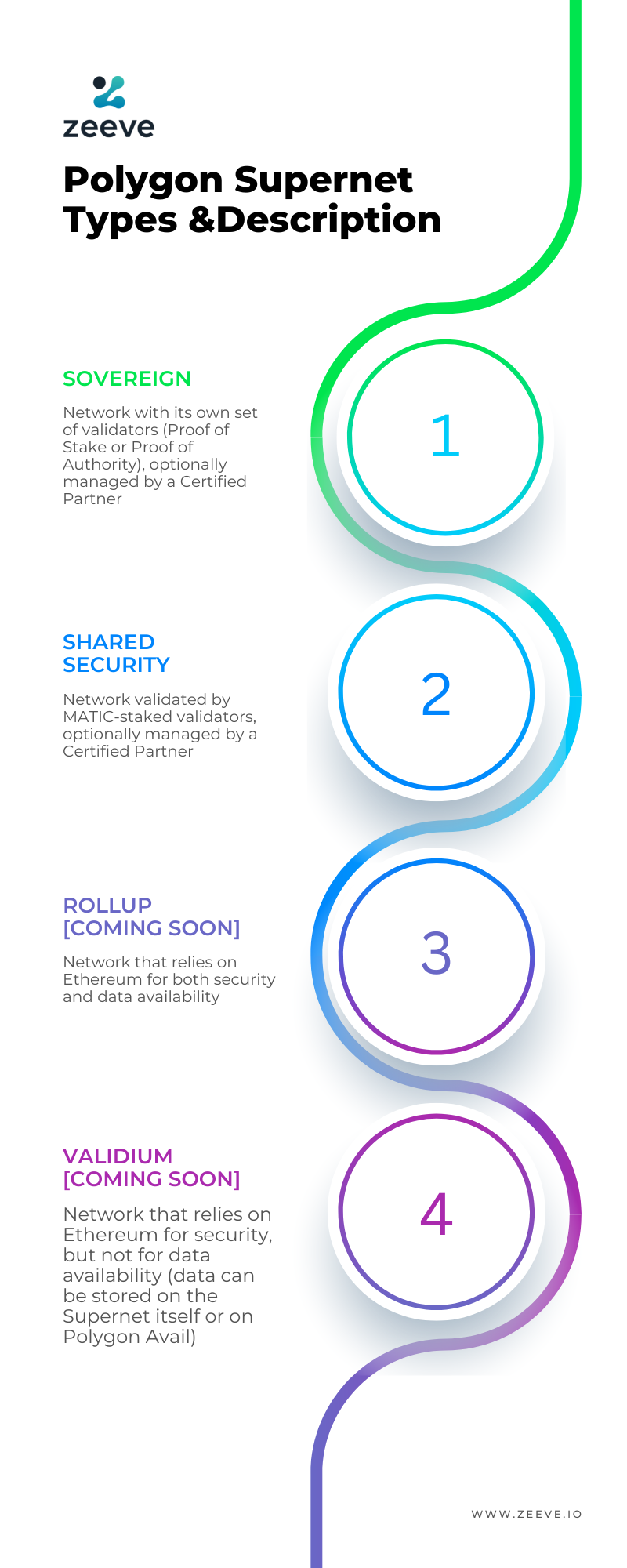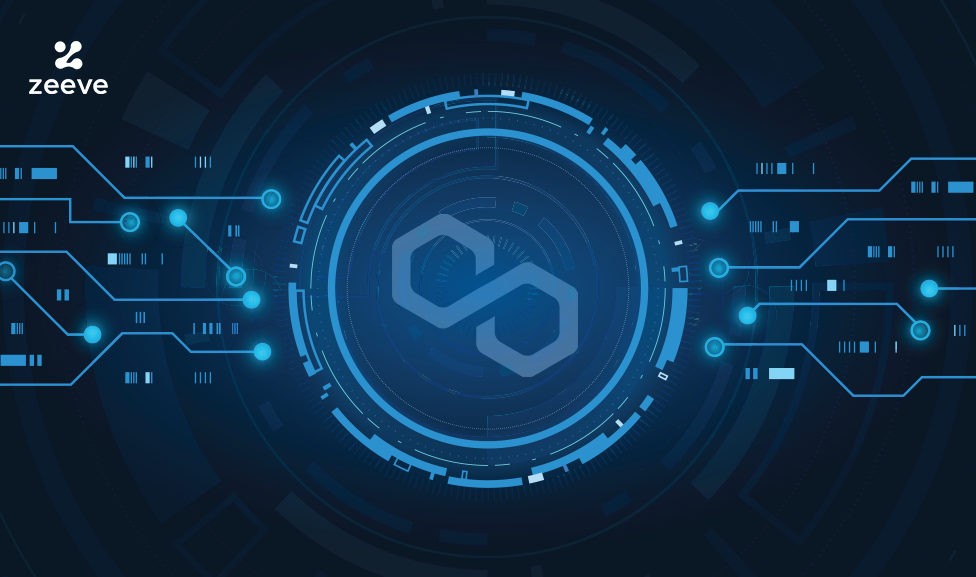Blockchain is the inevitable future, promising to transform the global marketplace for the better. It has completely upended the key drivers of the economy, including healthcare, supply chains, food production, insurance, law, intellectual property, real estate markets and many more. The innovative technology fulfills its purpose of facilitating a decentralized nature of the blockchain database and provides safe, immutable data in its secure blockchain database. While blockchain technology is still in development, there are many adoption challenges that are yet to be resolved. The problem of mass adoption of blockchain is a highly pertinent problem and in fact scalability remains as one of the bottlenecks towards its implementation. One potential solution to this problem is supernets. In this blog guide we will delve deeper into Supernets – Polygon supernets that serve as a type of network using blockchain technology to allow for more efficient communication between nodes. They solve the problem of mass adoption by making it easier for people to find and use applications that use web3.
Origin Of Polygon Supernets
For several reasons, the web3 project may choose not to use Ethereum’s underlying network. For instance, it may be testing out new or unique functionality from the mainnet that is not readily available, or the desire to get a better handle on network appropriability.
In May 2021, Polygon Edge was announced by Polygon. It was designed to offer a multi-chain Ethereum gateway to blockchain developers.
Polygon Edge is a blockchain stack specifically designed to help you build your own references to network blockchains for your particular requirements. With its modular architecture, the Polygon supernets stries to provide developers with scalable infrastructure solutions and hence features the sovereign and enterprise EVM (Ethereum Virtual Machine) chains and complex Layer 2 solutions.
So far, scalability and throughput have been identified as the biggest pain points for software developers working with public networks. Developers looking for quick and easy solutions that facilitate smooth scalability even in cases of heavy network traffic could resort to Polygon Edge. It is aptly suited for decentralized and blockchain applications that have on board millions of active users. The scalability feature lets the users complete tens of millions of transactions per day smoothly.
Polygon Edge is modular and configurable while also easy to understand along with some great features to use. The team at Polygon tried to incorporate the modular architecture approach from the blockchain world into their client architecture and introduced separate modules for the important layers of the stack (execution environments, consensus, data sharing, network communications, and so on). These modular Legos possess many important attributes that make them more powerful and efficient when compared to classical software.
Enhanced performance, constant and predictable throughput and the availability of customization through the configuration of every aspect of the blockchain network are some of the benefits attained by the web3 developers and enterprises using the Polygon Edge.
However, some common challenges were identified by the users of the Polygon Edge. There were security issues in the network as challenges were encountered with bootstrapping the decentralized and powerful validator set with handy coordination mechanism. Consumption of immense bandwidth of the application team also came across as a deterring factor for the widespread use of Polygon Edge. Technical complications entailed in the functioning of blockchain networks and some important security concerns prompted the Polygon team to design the Polygon Supernets, building on the success of Polygon Edge.
What are Supernets?
Supernets are clusters of connected networks that can be used for a variety of purposes, including data sharing and collaborative work. They have been popularized by the Googleplex, a massive supernet consisting of more than 100 interconnected networks. Supernets can be useful for organizing large amounts of data and for facilitating communication between different groups of users.
Supernets can exchange messages and value with other Supernets and with the main Ethereum network. Validators on each Supernet participate in the MATIC mainnet before validating the network to check its security level.
In May 2021, Polygon Edge announced the Layer 2 blockchain scaling solution. Layer 2 Stack provides a platform for connecting independent Layer 2 chains using smart contracts between blockchains developed by independent parties and controlled by all parties.
Polygon is being used for multiple projects. Polygon acknowledges its goal is to bring mass adoption of Web3, so it considers the idea of Supernets a major step in its implementation. Naturally, Polygon classifies itself as a sort of massive scalability solution consisting of numerous Publicnets (public nets, such as Polygon POS or upcoming Polygon Hisarez), plus a standalone blockchain based solely on the principle of Supernets, whose objective is to achieve the maximum transparency possible between validator nodes.

Function of Polygon Supernets
Polygon supernets are a powerful tool for understanding complex data structures. They allow us to see relationships between different pieces of data that would be difficult or impossible to see otherwise. This article will introduce you to the basics of polygon supernets and show how they can be used to solve problems.
Polygon Supernet is a blockchain system built on the Polygon Edge stack. It can also be called an ecosystem, a set of modules that work together seamlessly and add new functions as they accumulate.
Supernets let you create a distributed blockchain network that is designed to meet your specific requirements and provide a more desirable blockchain network installation experience than typical. They will praise themselves for improved speed, continual and reliable throughput, and broad customization through any settings chosen. Web3 applications can be integrated directly into dedicated networks, letting you optimize them in a recent blockchain format. They’re well known for their performance, constant and predictable throughput, and customization through configuration.
Benefits of Using Polygon Supernets
Polygon supernets works provide a number of benefits, including but not limited to: improved network security, increased efficiency and communication, and enhanced data interoperability. These networks can be used to enhance the performance of a variety of applications and systems, and are often recommended for use in industries such as telecommunications, finance, logistics, healthcare, and manufacturing.
Read through some of the most significant of those characteristics of Polygon supernets that make them a favorable scalable solution:
Supernets are dedicated
Each Supernet is designed and able to run for a single project or use case. Originally, Supernets were developed for particular specific purposes, but it has lately been used for a wide variety of reasons. The benefits of this dedicated Web 3 hosting system are that they are dedicated networks that can be used for specific purposes. For example, a supernet can be used to connect universities so that students can easily transfer between them. Supernets serve as an important tool for storing data and also retrieving them.
Supernets can be secured by Polygon’s MATIC
Edge’s MATIC platform will provide an option for Polygon users seeking to use proof-of-stake technology as a security measure. A “shared security” mechanism is being introduced by Matic as a staked validator marketplace. The web3 projects and developers who wish to take advantage can fully utilize this service and in return they will immediately gain access to a decentralized, trusted Proof of Stake validator set, thereby removing the difficulty of bootstrapping a validator network.
In addition to validators staking MATIC and collecting rewards from this program, there is no effort needed by application project teams during validator incentivization and sustainability. With Proof of Stake security solutions, individuals may not have to devote extra time and resources to projects. The team at Polygon understands that people may have different expectations about the service, but it intends to make the usage of this optional service incredibly popular given its multiple benefits. Keep following Polygon as they share more information about this service period of days or weeks.
Supernetworks are interconnected by Ethereum
As Supernets are interconnected with one another, exchanges of value and messages can be accomplished with other Supernets and with the Ethereum network. In the future, exchanges can be completed using different bridge implementations and integrations that are offered by Edge. In the long term, Polygon is exploring the possibility of a larger, more formal effort to design.
Edge-certified partners can monitor Supernets.
Building, operating, maintaining and keeping the blockchain networks up and running are formidable tasks, and app developers often lack the necessary know-how and also the expertise to perform them successfully. These can be highly time-consuming and resource-intensive efforts that can be arduous. In an effort to solve this problem, Polygon is also making available Edge Certified Partners, a team of certified development shops and teams that can complete or significantly take over these parts.
Supernets can utilize any scaling architecture
To pick out the various Polygon Edge blockchain legos, i.e. architectural options provided by our company, remember to note that only the above ones (Simple, Trusted, and Protected) will be accessible through Supernets. The ease of use and multiple set of advantages of Supernets is merely making it easier for the developers to deploy and run the apps.
As a Supernet gradually grows, it can change different aspects of its architecture in order to current demands. For example, Supernet Polygon Edge can begin as a sovereign Proof of Authority network, then transition into a Proof of Stake network, and eventually move to a full-fledged Layer 2. Ownership of the underlying software can be transferred at any time.
Set up a customized, high-speed, excellent performance blockchain network on Supernets
Supernets allow for the quick and easy set-up of a custom high performing blockchain network. Their modular design allows for rapid deployment of new features, without sacrificing overall performance. Supernets also provide an open architecture that makes it easy to integrate with existing blockchain networks.
Bootstrap decentralized validator sets quickly
Supernet’s blockchain platform helps immediately bootstrap validator sets via Polygon’s network of professional validators. Supernet offers a unique solution for developers who want to launch decentralized applications (dApps) quickly and easily. Supernet also provides a secure, flexible, and scalable blockchain infrastructure that supports millions of transactions per second.
With the use of polygon’s supernets developers can also get access to a wide range of premium web3 developer tools and full-suite of services.
Architecture
Supernets use an L1 blockchain network, or Polygon Edge. Supernets are at the center of the entire functioning of Polygon Edge. There are 6 key building blocks in the architecture of Edge.
JSON-RPC – The Ethereum client-specific API interface is the layer satisfying the JSON-RPC criteria for the Polygon Supernet, GraphQL. It ensures that various plugins can be calculated on the Supernet.
The TX Pool – Module that contains the pending orders and acts as a transaction pool. Multiple sources are able to initiate transactions, and it is closely integrated with other modules in the Edge.
The blockchain is a database that tracks world state, smart contract codes, accounts, and so on. Developers can find 2 prime modules, with the first one being the RLP serializer that translates data into the Ethereum format. The second is the data aggregator that will put together information in Rich Lists for fast searches and verification of immutability.
Consensus algorithms embedded in the Supernet, such as IBFT Proof-of-Achievement (Proof-of-Authority) and Proof-of-Signiture (Proof-of-Stake), are incorporated.
Libp2p is currently an up-to-date networked peer to peer stack that facilitates consensus statements, blocking syncing, the practice of sharing SAM pools, and the practice of sharing Tx pools.
gRPC — A gRPC-based robust communication protocol is used to distribute privileged system commands. The commands can only be executed on local validator nodes for scheduling online backups, querying and clearing the pool, and retrieving validator messages.
Polygon Supernets architecture
Supernets using IBFT PoA are the default Consensus option. In IBFT, validators are responsible for building blocks that get added to the network. All validators set up a queue where validators can be added or removed by using a specific vote. To be included or dropped from the line, a validator must be voted for by at least one of the leaders on the ranked validator list. This protects the integrity of the network and also boosts its security.
Validators take turns in subsequent blocks (round-robin), and for the block in question to be inserted into the blockchain, no fewer than 2-3s are required to check its validity.
Txs propagation
Transactions need to be transmitted directly to a node, which will then send them onward to be broadcast to the entire network.
Trustless secure environment
A supernet is made up of a network of nodes, each of which validates every transaction by deciding upon the smart contract. All nodes consistently execute the same blockchain framework ledger. A malevolent attempt to alter it is difficult because all nodes feature the identical copy of the blockchain. Malicious efforts to misrepresent the principles in the ledger can easily be detected by an incorrectly hashed invoice from a relatively distinctive state.
Supernet supports EVM and smart contracts
Supernet has the incorporation of EVM (Ethereum Virtual Machine), a widely-understood tool in and dependable cryptographic circle, built-in. This signifies smart contracts made on a Supernet are EVM bytecodes compiled from a high-level language, such as Solidity. Solidity contracts can be easily ported to Supernets with no changes required. So, developers with Ethereum experience can use Supernet utilities like Truffle suite, Hardhat, MetaMask, Remix, and block explorers to create new applications for them with ease.
Token support
Supernet support lets the users utilize the EVM to create a token by incorporating a standard interface, such as ERC-20.
Functioning ways
Supernet can work even very differently depending on the needs of your project: L1 Supernet a chain validated by professional validators who offer to verify it, and L2 Supernet – an even more scalable solution using a web of blockchains for web applications.
Bootstrap Ethereum-compatible blockchains with Polygon Supernets
Using the Polygon supernets, one can easily set up and also run a custom blockchain network. Below are some of the steps required for it:
1. Generated data
Each node needs keys called validator and node networking to be able to successfully communicate with and participate in conversation with other nodes. They generate the private key on each node.
2. Genesis configuration
The genesis block is the place where a chain of any blockchain begins. Users must set up a genesis hash before their journey and will be prompted to specify all of these choices. It can be found in the documentation.
3. Start the node
Everything is set up now, so all node functions can be run. Whenever opening a node, users can specify custom runtime parameters. The full list of supported parameters is provided in the documentation.
When all nodes are started, they will attempt to locate a fully-connected network and build blocks.
Concluding thoughts
If the mass adoption of Web3 is to be realized, it is crucial to comprehensively explain the complexities of blockchain technology and simultaneously provide scalability and personalization. Polygon Supernets help to deliver this, enabling any enterprise to speed up their plans and become part of Polygon’s ever-expanding multi-chain ecosystem.
About Zeeve
Looking to deploy a polygon node, rely on the enterprise-grade web 3.0 infrastructure platform – Zeeve for deploying, monitoring, and scaling nodes. Using Zeeve’s resources, Polygon nodes can be deployed in seconds with the desired cloud. It has ready plugins, including APIs, tools, and libraries for setting up a secure Polygon node. It is intended for reliability, availability, and functionality, allowing developers to build dapps, smart-contracts, and dApps. Zeeve’s built-in architecture for deploying nodes with highly secure RPC endpoints allows for smooth and swift communication with Polygon Heimdall and Bor layers securely. The node also includes highly configurable components that can be connected to the existing Polygon system using the Polygon node’s node to embed some of its features.
You can rely on Zeeve to create a Polygon-based network where blockchains interact to establish trading systems along with data helpful in providing decentralized solutions. We deliver a platform that consolidates the various communication paths between blockchains. Sign up now.





